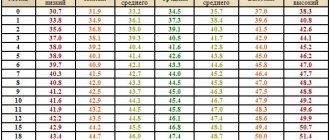Each child at birth is checked for weight and height, the norms of which are presented in the corresponding centile tables developed by the World Health Organization. Another way to verify data is to use online calculators. They usually include parameters that children must have from birth to 12 years of age. For parents, these numbers are of particular importance, as they are a sign of normal growth and development of the child or signal deviations from standard indicators.
Timely measurement of a child’s height and weight is important for determining the norm of his development
What it is
BMI is an abbreviation for body mass index. In English it sounds like Body Mass Index (BMI). This is a parameter that reflects the degree to which a person’s weight and height correspond. Allows you to objectively assess whether he has extra pounds, whether he suffers from exhaustion, or whether everything is normal. Most often used in two cases.
Firstly, the doctor suggests calculating the body mass index if obesity and eating disorders are suspected in order to accurately diagnose and prescribe appropriate treatment.
Secondly, calculating BMI is necessary in order to control your figure, correct it and, if it deviates from the norm, take appropriate measures.
Weight factors
Almost all deviations from the norm, determined when calculating on an online calculator, should not be a reason for panic. The main parameters for losing weight or gaining pounds depend on a number of different factors that need to be taken into account:
- Genetic predisposition. The offspring of large parents will also have upward deviations in the same parameters. And thin, short parents very rarely grow up to have a daughter or son who is overweight.
- Health status. Both diseases that directly affect weight (for example, endocrine diseases) and ordinary diseases that worsen the baby’s well-being, which leads to loss of appetite, play a role here.
- Appetite. Everyone has a different relationship with food and a different appetite. If your weight does not deviate greatly from the norm, you should not force or restrict your diet, but the diet should be healthy - without fast food, chips, soda and other junk food.
- Lifestyle. This is the most common reason for gaining excess pounds. Modern children spend little time outside, playing sports or playing active games. Parents should limit the time they spend sitting at the computer and organize their daily routine correctly.
By ensuring the correct regime, active pastime, eating healthy and tasty food, you can completely avoid your son or daughter from gaining extra pounds or lack of them due to lack of appetite. And using an online calculator will help you easily monitor their harmonious development.
Generally accepted formula
Now the BMI formula is officially used, developed in the mid-19th century by Adolphe Quetelet, a sociologist and statistician from Belgium. It takes into account only two parameters - height and weight, which does not make it ideal for identifying excess or missing kilograms. And yet, for many decades it has been used in medicine.
The Quetelet calculation formula looks like this:
I = m/h2
According to it, to calculate your body mass index, you need to divide your weight in kilograms (m) by your height in meters squared (h2).
Example:
- m (weight) = 80 kg;
- h (height) = 1.6 m;
- square meters: 1.6 x 1.6 = 2.56;
- I = 80 / 2.56 = 31.25.
This completes the calculation of the body mass index: it is equal to 31.25. We remember this figure and compare it with normal indicators, according to the table below.
Interpretation of results
As a result of the calculation, the calculator displays height and weight indicators - low, medium and high. Each of them is interpreted accordingly.
Height (length)
For children under 3 years of age, body length is measured; after 3 years of age, height in a standing position is measured. The difference between these parameters can be of the order of 1 cm, which will affect the assessment results. Therefore, for accurate calculations, it is recommended that small children be measured by a pediatrician, since this indicator is one of the most important.
Possible height (length) estimates using the calculator:
- Very low - much lower than normal, which indicates a significant developmental delay, often accompanied by extra pounds. An examination by a doctor is recommended to determine the cause and treatment.
- Low - a slight lag, which can also lead to excess kilograms. Consultation with a specialist is advisable.
- Below average - not high, but within normal limits.
- Average - determined in many healthy boys and girls.
- Above average - within normal limits.
- High - rare and, as a rule, is hereditary, without indicating any abnormalities.
- Very high - may be the norm if the parents also differ in the same parameters, or a sign of an endocrine disorder. It is recommended to consult a doctor.
Weight
The weight indicator alone does not allow a full assessment of the child’s development. But if, according to the results of the calculator, body weight is determined to be very low or extremely high, then this is a reason to consult a doctor.
Possible estimates using the calculator:
- Very low - there is a great danger of exhaustion of the body. Immediate examination by a specialist is required.
- Low - there is also a possibility of exhaustion; consultation with a doctor is necessary.
- Below average is the lower limit of normal, the diet should be reconsidered.
- Medium is ideal for many healthy girls and boys.
- More than average - with this indicator it is necessary to carry out an assessment taking into account BMI.
- Very large - also estimated based on body mass index.
Body mass index
The harmonious development of a child does not depend on age, but is determined by the body mass index (BMI), which is calculated as the ratio of height and weight. Thus, the ideal weight for a 13-year-old girl of average height (151.8 cm) will be 43 kg, and for a 14-year-old girl of short height (147.8 cm) - 37.6 kg. In teenage boys, this difference is less pronounced, since during this period they develop less intensively. For example, a short (136.2 cm) teenager 12 years old should weigh 28.2 kg, while an 11 year old boy of average height (138.5 cm) should weigh 31 kg.
The body mass index indicator is individual for each person. It can be calculated using a special BMI calculator on our website. It should also be taken into account that there are reasons that affect the decrease or gain of kilograms. Almost all of them can be adjusted to achieve optimal body weight.
Norm and deviations
On the official WHO website there is a special table that shows both the BMI norm and deviations. Using it, we look for which category we fell into with our I = 31.25.
We did not fall into the normal body mass index, and the table no longer shows just extra pounds, but class I obesity (an overview of obesity classifications can be found at the link).
So calculating BMI and comparing the data obtained with the norm is not at all difficult. The problem is that the formula is already outdated, and the WHO table does not reflect all factors. This means that the results may not be entirely correct.
For adults
Since weight is influenced by gender and age factors, tables have appeared in which you can see the norm and deviations from it separately for women and men, and even taking into account age. As experts note, here the data is more accurate and correct.
First you need to calculate your BMI using the formula, and then find the resulting value in the tables below in accordance with your gender and age.
For men based on age
For women, taking into account age
Depends only on gender
Depends only on age
Anything below normal is underweight. This means that you urgently need to gain the missing kilograms. If the result exceeds the parameter indicated in the table by 5 units, you are overweight. If the difference is more than 5, you should seek qualified help, since we are most likely talking about obesity.
Online weight and height calculator
In infancy, even minor changes in a child's development are important. An online calculator will help you estimate your baby’s height and weight, taking into account his age, accurate to the day. Such a system eliminates the need to constantly search for norms of parameters and their correspondence to reality. Just one click of a button will give you a ready-made assessment and preliminary conclusions. The online calculator fully replaces the table used by all pediatricians, while taking into account the errors allowed for infants of different sexes.
Child height and weight calculator widget
Child
Age
Weight
Height
For children
To calculate BMI for children, you will need the same formula, but the table, accordingly, will be different. In a child, metabolic processes proceed much faster, and energy costs are several times higher than in adults. Therefore, it is imperative to use other standards.
For boys
For girls
The jumps from 7 to 9 years are explained by the body’s preparation for adolescence and puberty.
Regular determination of a child’s BMI allows parents to control his weight and promptly prevent both exhaustion and the appearance of extra pounds (read about the features of childhood obesity here).
Ideal weight calculation
You can find out your ideal body weight using various formulas that use different parameters for calculations.
General designation (R - height):
- Bornhart index: R in centimeters x (multiply) by chest circumference in centimeters / (divide) by 240;
- Breitman index: R in centimeters x 0.7 - 50 kg;
- Broca–Bruksht index: for women R in centimeters – 100 – (R in centimeters – 100) / 10; for men R in centimeters – 100 – (R in centimeters – 100) / 20;
- Davenport index: weight in grams / R in centimeters squared;
- Korovin index: you need to measure the thickness of the skin fold near the 3rd rib (normal 1-1.5 cm) and at the level of the navel (normal 1.5-2 cm);
- Noorden index: R in centimeters x 420 / 1,000;
- Tatonya index: R in centimeters - (100 + (R in centimeters - 100) / 20).
There is also a small addition to the Broca-Bruckst formula: after the result obtained, you need to measure the volume of the wrist, and if it is less than 15 cm, subtract 10% from the ideal weight; at 15–18 cm we do not change anything, if more than 18, we increase the ideal weight obtained according to the formula by 10%.
Using any formula, calculating your ideal body weight is easy. The main thing is to draw objective conclusions after comparing the results obtained with real numbers. If the difference in both directions (more/less) is more than 5 kg, then there are problems that are better to start solving immediately.
Reasons for fast and slow weight gain
According to the norms, by the end of the first year of life, the child gains about 7 kilograms of weight. Permissible deviations are also taken into account, but at this age they are insignificant. What if your child develops differently? What reasons can cause too fast or slow weight gain?
Reasons for slow weight gain in infants:
- Natural weight loss after birth. Typically, a baby loses weight in the first few days of life due to the stress of birth and adaptation to new conditions. Sometimes this period can drag on a little.
- Incorrect chest grip. If your baby doesn't latch on properly, he may not get enough fatty hind milk and have trouble gaining weight.
- Using bottles and pacifiers. Fast and infrequent feedings, which are typical for artificial feeding, lead to insufficient weight gain.
- Additional soldering. If a breastfed baby is given extra water, he will eat less milk and receive insufficient nutrients.
- Lack of mother's milk. If the mother is healthy and feeds the baby on demand, she will have enough milk - this is how nature intended. Insufficient production may occur due to illness, another pregnancy, excessive physical activity, or additional feeding with artificial formulas.
Excess body weight is more typical for bottle-fed children. When using formulas, you must strictly observe the interval between feedings and dosage, taking into account the age of the child. Sometimes rapid weight gain may indicate the presence of diseases or a genetic predisposition.
The main thing that doctors pay attention to is the child’s condition. If his weight is slightly different from normal, but the baby is active and in a good mood, most likely there is nothing to worry about.
Important note!
We draw your attention to the fact that in different sources, data on the norm and deviations of BMI for men, women and children, taking into account age, may differ quite significantly, with the exception of the general table recommended by WHO. The fact is that the parameters are calculated using different methods and formulas - hence the difference within one unit. In this regard, all parents are recommended to use the data for children only as a guide and, in case of doubt, be sure to consult a pediatrician without taking any independent measures.









